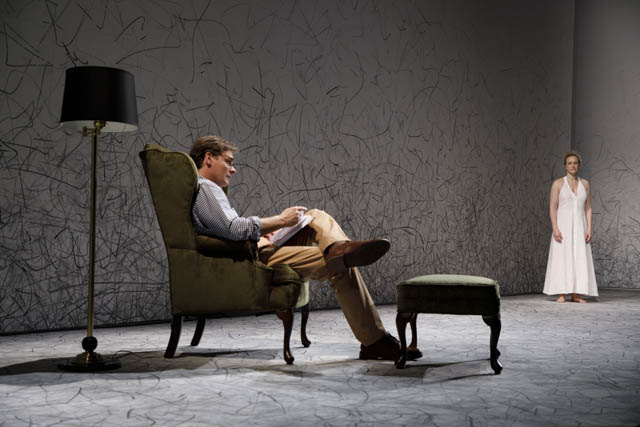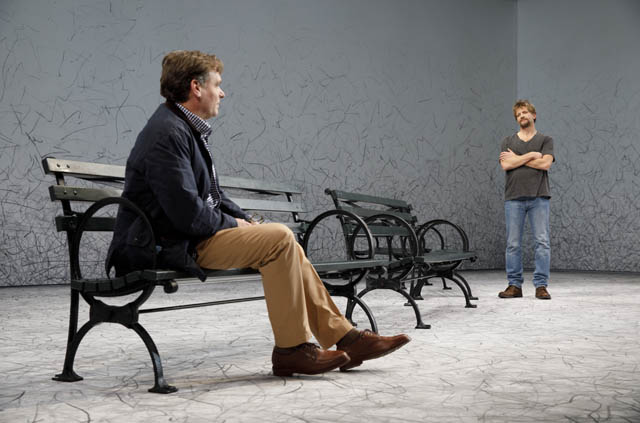
Peter (Robert Sean Leonard) and Ann (Katie Finneran) have settled into a comfortable existence in Homelife (photo by Joan Marcus)
The Pershing Square Signature Center
The Irene Diamond Stage
480 West 42nd St. between Tenth & Eleventh Aves.
Tuesday-Sunday through March 25, $65-$85
212-244-7529
www.signaturetheatre.org
“We should talk,” Ann (Katie Finneran) says to Peter (Robert Sean Leonard) at the beginning of Edward Albee’s At Home at the Zoo, a two-act play running at the Signature through March 25. “Do you mind if we talk?” Jerry (Paul Sparks) asks Peter in the second act. Every word matters in Albee’s minimalist play about language, communication, and loneliness. The second half of the work, The Zoo Story, began as a one-act play first performed in West Berlin in 1959. Nearly fifty years later, in 2004, Albee added a prequel, Homelife, in order to flesh out the character of Peter. Initially known as Peter and Jerry, the retitled Edward Albee’s At Home at the Zoo opens with Peter sitting in a chair with a matching ottoman, reading a book under a lamp. Andrew Lieberman’s set is otherwise bare, except for Cy Twombly–like pencil scribbles on the white walls and floor that could be editors’ marks (Peter works for a text-book publisher) while evoking a certain randomness. The forty-five-year-old Peter and the thirty-eight-year-old Ann live on the Upper East Side and have settled into a cozy, rather ordinary life. While that pleases Peter, Ann appears to want more. She leads their discourse from daydreams of public nakedness to contemplations of morality and mortality; before we know it, the two are deep in polite conversation about the mundane violence visited upon upper-middle-class sex organs: from prophylactic breast removal to infant circumcision. “Once you hear of an idea you never know where it will lodge itself, when it will move from something learned to something . . . considerable, something you might think about, which is not far from being thought about, if you wanted to, or needed to,” Ann says. “We all die of something,” Peter responds. Ann: “Sooner or later.” Peter: “Yes, but . . .” Ann: “Yes, but! Oh, you do love pedantry so . . . dying of not doing something can be carelessness!” Much of their conversation involves the semantic use of words; the couple exists together — and indeed is still happy — more through language than action. In the world they’ve created, being comfortable is not really a problem; in fact, Peter is so comfortable that he spends virtually the entire act seated in his chair. “I love you dearly,” Ann says. “But where’s the . . . the rage, the . . . animal? We’re animals! Why don’t we behave like that . . . like beasts?! Is it that we love each other too safely, maybe? That we’re secure? That we’re too . . . civilized? Don’t we ever hate one another?” That will have to wait until after intermission.

Peter (Robert Sean Leonard) and Jerry (Paul Sparks) talk it out in The Zoo Story (photo by Joan Marcus)
The second act, The Zoo Story, opens with Peter sitting on a park bench, reading. A stranger who later identifies himself as Jerry approaches him and says, “I’ve been to the zoo,” an ingenious transition from the first act, in which Ann was talking about animals and beasts. Speaking expressively in disjointed thoughts, Jerry is everything Peter is not; aggressive, unashamed, unfiltered, and, perhaps most important, potentially dangerous. “I don’t talk to many people,” Jerry tells Peter. “But every once in a while I like to talk to somebody, really talk, like to get to know somebody, know all about him.” Understandably uncomfortable, Peter responds, “And am I the guinea pig for today?” After a long, convoluted story about his landlady and her dog, Jerry does more than talk as he invades Peter’s space, leading to a shocking conclusion. Edward Albee’s At Home at the Zoo features fine performances from Tony winner Leonard (The Invention of Love, House) as the gentle, mild-mannered Peter and two-time Tony winner Finneran (Noises Off; Promises, Promises) as the curious and concerned Ann, but Albee saves the fireworks for Jerry, a bundle of nervous energy superbly embodied by Emmy nominee Sparks (House of Cards, Boardwalk Empire); he’s like a caged animal waiting to burst free, exacerbating a situation where anything can happen at any moment. (Perhaps the marks on the walls were made by human animals trying to escape their theatrical fate.) Drama Desk Award winner Lila Neugebauer (The Wolves, Everybody), who directed Albee’s 1959 one-act The Sandbox at the Signature in 2016, keeps the tension building in both sections of the play, which come together seamlessly. Of course, Albee, who was the Residency One Playwright at the Signature in 1993-94, is making a direct connection between theater and zoos, two places where humans pay money to watch others perform for them. Thus, Albee feels right at home at the Signature (as well as at the zoo; the author’s name in the title could be read as a possessive or as the subject of the sentence). And just like at the zoo, nobody likes to see sleeping animals; children and adults want to see some action, which is just what Albee gives them in the end.